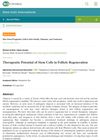TLDR Exosomes from stem cells can help regrow hair like minoxidil.
The study explores the potential of exosomes derived from human adipose-derived mesenchymal stem cells (hADSC-Exos) in treating androgenetic alopecia. These exosomes enhance dermal papilla cell proliferation through the Wnt/β-catenin pathway, counteracting the effects of dihydrotestosterone. The research demonstrates that hADSC-Exos can significantly promote hair follicle regeneration, showing comparable efficacy to minoxidil in an androgenetic alopecia mouse model. The study highlights the promise of exosome-based therapies as a cell-free approach for hair restoration, though challenges such as scalability, standardization, and regulatory approval remain before clinical implementation. Future research should focus on optimizing production, exploring signaling pathways, and conducting large-scale trials to validate efficacy and safety.
 March 2025 in “World Journal of Stem Cells”
March 2025 in “World Journal of Stem Cells” Stem cell exosomes may help treat hair loss by promoting hair growth.
June 2024 in “Regenerative Therapy” Exosomes from stem cells may help rejuvenate skin and regrow hair, but more research is needed.
 11 citations
,
May 2021 in “Dermatologic clinics”
11 citations
,
May 2021 in “Dermatologic clinics” PRP and cell therapies may help with hair loss, but more research is needed.
 September 2025 in “Clinical Cosmetic and Investigational Dermatology”
September 2025 in “Clinical Cosmetic and Investigational Dermatology” Exosome therapy shows promise for hair growth with minimal side effects, but more research is needed.
 8 citations
,
October 2022 in “Regenerative Therapy”
8 citations
,
October 2022 in “Regenerative Therapy” New regenerative treatments for hair loss show promise but need more research for confirmation.
 45 citations
,
August 2018 in “Stem Cells International”
45 citations
,
August 2018 in “Stem Cells International” Stem cells, especially from fat tissue and Wharton's jelly, can potentially regenerate hair follicles and treat hair loss, but more research is needed to perfect the treatment.
 October 2025 in “Cell Transplantation”
October 2025 in “Cell Transplantation” New hair loss treatments like stem cells and gene therapy show promise but need more research for safety and effectiveness.
 113 citations
,
November 2017 in “Scientific Reports”
113 citations
,
November 2017 in “Scientific Reports” Tiny particles from stem cells help activate hair growth cells and encourage hair growth in mice without being toxic.









